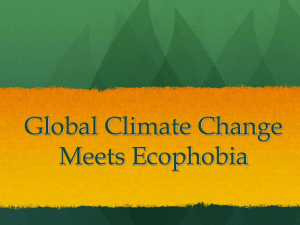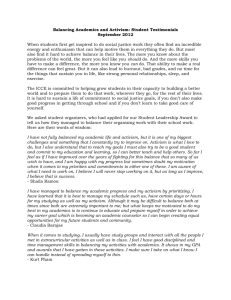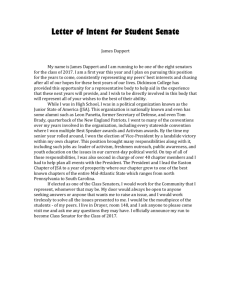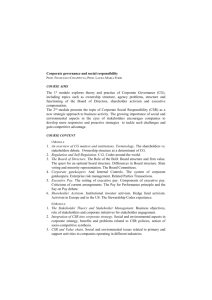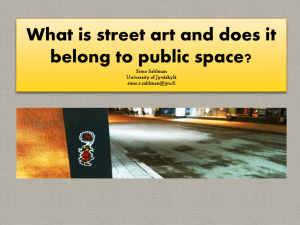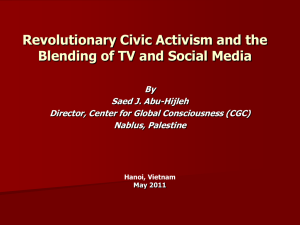Why Peace? Stories of Activism and Altruism in Indiana cO
advertisement
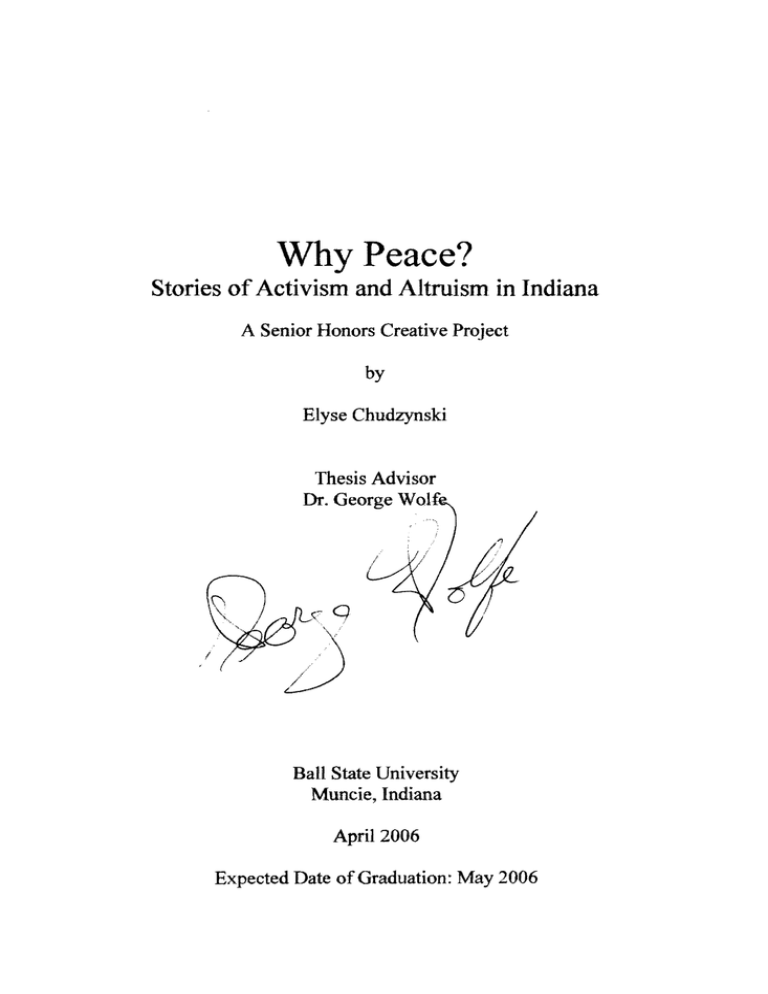
Why Peace?
Stories of Activism and Altruism in Indiana
A Senior Honors Creative Project
by
Elyse Chudzynski
Thesis Advisor
Dr. George WolE
cO
,
I
;'
!
Ball State University
Muncie, Indiana
April 2006
Expected Date of Graduation: May 2006
Why Peace? Chudzynski 2
Abstract
Graduating from college is an enonnous transition, and once made it can be
especially difficult to integrate past hobbies and interests into daily life. This includes the
work of an activist. After finding myself approaching this transition I had questions
regarding activism and the commitment, passion, and motivation involved. Psychology
has many theories on aggression and war; however, some psychologists have, instead,
focused on the altruistic individual or the committed activist. I explored this aspect of
human nature by interviewing six individuals, all located in Indiana, who actively work
for social or political change. This project broadens the meaning of the word activism to
include any type of action that may improve the life of another or help a community to
grow. The interviews are presented in the fonn of film with an introduction and
conclusion narrated by David Chudzynski. The stories shared by these six individuals
offer encouragement and advice for those hoping to incorporate activism into life after
college.
Why Peace? Chudzynski 3
Acknowledgements
* I would like to thank Dr. George Wolfe for advising me through this project. He
provided me with insight and a variety of perspectives throughout the creative process.
* I would also like to thank all those I interviewed: Gerry Waite, Bibi Bahrami, Brenna
Cussen, Earl Muterspaugh, Charlie Swander, and Dr. George Wolfe. Without their
selfless acts and open hearts I would not have been able to complete such a project. They
are true role models and I am grateful for their generosity and participation.
* Finally, I would like to thank my father, David Chudzynski, for narrating the film, as
well as the rest of my family and friends who encouraged me throughout the semester.
Why Peace? Chudzynski 4
During my sophomore year at Ball State I attended the public showing of the film
Uncovered: The Whole Truth About the Iraq War. I didn't know it then, but attending
that event eventually led to my own film: Why Peace? Stories ofActivism and Altruism in
Indiana. The movies are unrelated as far as content, but it was at this event that I
discovered the campus organization Peace Workers and began my personal journey
toward activism. As I was becoming an informed citizen I was, in essence, thrown into
various causes and I felt it was time to become a member of something larger than
myself. After two years as an executive member of Peace Workers, I learned a number of
valuable lessons, including skills relating to activist organizations and peace movements.
I discovered the inevitable debates that arise in these types of groups, the right and wrong
ways to recruit, and the constant emergence of new issues and interests. This was the first
step in my own journey, and as I struggled to be an effective Peace Worker I began to
look to others.
This past summer I wanted to explore how other peace groups might work and
how they stay active despite their other time commitments. Living at home in South Bend
I decided to attend the Michiana Peace and Justice Coalition (MPJC) meetings. It was
there that I met a number of individuals who have their own careers and yet are still
committed to activism and serving their community. After a few meetings and events
with these individuals, I learned that dissent is a natural part of every peace group and it
can oftentimes be beneficial. Over the summer I also met with Paul Mishler, a member of
MPJC and a labor studies instructor at Indiana University South Bend, who gave me
some further insight into activist organizations. He addressed the transition that college
activists must make, leaving the position of a student and becoming an independent adult
Why Peace? Chudzynski 5
with a career. I honestly hadn't considered it, but after talking with Paul I realized that
incorporating community service and/or activism into my daily life after graduation
would be a difficult task.
This got me thinking. I wanted to learn more, but the summer was short and soon
I was back at Ball State asking myself some important questions. As a senior I began to
wonder where I might be the following year. This caused overwhelming anxiety and led
to a dispassionate, half-hearted commitment to service, activism, and Peace Workers.
Luckily I encountered this dilemma during fall semester instead of this spring. After
calming my "future plan fears," I began to ask myself some other daunting questions. I
was a little less nervous this time, and the questions were ones that I felt could be
answered, if I devoted an entire semester to them in the form of an Honors Thesis. My
questions related to my personal experience in Peace Workers but also to the broad
definition of activism. The questions included:
"Why was it so difficult to recruit new people to Peace Workers?"
"How do you know when your actions are effective?"
"How will I stay active in the future? "
"What does it mean to be an activist? "
and
"What is activism, anyways?"
This is where my major in psychology began to intervene. I began to study the
theories behind war, aggression, and violence. I found a long history of scholars
suggesting various origins of violence and reasons for war. Since psychology has existed,
various new concepts have arrived including the concept of unconscious aggression
Why Peace? Chudzynski 6
developed by Sigmund Freud. Freud suggested all humans have a death instinct,
Thanatos, which he characterized as an unconscious need to destroy in order to prevent
self-destruction. He described human behavior during war as disillusionment, a
perversion of intellect, reason, and scientific thought, but claimed this impulse was
primitive compared to the expectations we fulfill in society. Thus, when our own
societies place restrictions upon our behavior and breed hatred for other nations and
peoples, our instincts are allowed expression and we are capable of cruelty and evil
(MacCurdy 1918).
Freud is famous for many reasons but I was intrigued, to say the least, when I
discovered his correspondence with Albert Einstein on this very subject. The thought of
these two monumental characters discussing world matters was exciting enough that I
considered writing an entire thesis on their correspondence. Einstein originally
approached Freud on behalf of the League of Nations, whose Permanent Society of Art
and Letters was trying to create dialogue between scholars in various fields. In the first
letter Einstein asked a question that initially surprised Freud, yet it was one that Freud
had tried to answer as a psychologist for many years.
"This is the problem: Is there any way of delivering mankind from the menace of
war? It is common knowledge that, with the advance of modem science, this issue
has come to mean a matter of life and death for Civilization as we know it;
nevertheless, for all the zeal displayed, every attempt at its solution has ended in a
lamentable breakdown."
In that same letter Einstein went on to ask the additional following questions:
Why Peace? Chudzynski 7
"How is it that these devices succeed so well in rousing men to such wild
enthusiasm, even to sacrifice their lives? Is it possible to control man's mental
evolution so as to make him proof against the psychosis of hate and
destructiveness?"
These are legitimate questions and their impact continues to fuel many oftoday's nonviolent anti-war activities. Although I lacked Einstein's eloquence, I had asked myself
similar questions throughout my studies. The Einstein-Freud correspondence helped to
cement some of my personal feelings regarding war and violence, but at the same time I
was being pulled in another direction. In my research on the psychology of war I found
another idea that addressed these questions from a new perspective. While many believed
aggression was an integral part of human nature, there was another side to human
behavior, a peaceful nature. I first encountered this concept through the work of Dr.
Rachel MacNair and her use of Dr. Martin Seligman's positive psychology.
A New Perspective
Historically, most researchers in the past have studied humans as animals that go
to war, but Rachel MacNair (2003) offered a new perspective. Instead of the violent
human, some modem psychologists have studied the pacifist, the conscientious objector,
or the anti-war activist. MacNair used the term peace psychology to describe what she
studied. She defined peace psychology as "the study of mental processes and behavior
that lead to violence, prevent violence, and facilitate nonviolence as well as promoting
fairness, respect and dignity for all, for the purpose of making violence a less likely
occurrence and helping to heal its psychological effects."
Why Peace? Chudzynski 8
MacNair used Martin Seligman's concept ofthe optimistic explanatory style as a
model for non-violent activists. Seligman is the founder of positive psychology, a
relatively new approach which combines aspects of behaviorism and humanism in order
to offer a scientific approach to understanding life without neglecting talents and values.
When used as a cognitive therapy, patients are first encouraged to reexamine their life.
The therapist then asks the patient to attribute their situations to positive characteristics,
thus developing a process in which optimism improves the patient's perspective, and
generating the optimistic explanatory style (Seligman 1994). Many have responded to
Seligman's studies with their own interests, quickly building the field of positive
psychology (Schultz & Schultz, 2004, p.472). MacNair hypothesized that promoters of
peace and non-violence actually used the optimistic explanatory style in their analyses of
life, and this process allowed them to keep their commitments and stay motivated.
Their work and the questions they sought to answer inspired me to pursue this
area of study. However, I did not want to perform an experiment. Instead I wanted to hear
the honest, straightforward stories from those who display this side of human nature
everyday. I wanted to understand the reasons for the compassion and commitment of
those around me. My goal was to focus my attention on the personal experience of those
who act for peace on a daily basis. I wanted to hear their stories in person and ask
questions in order to gain another type of knowledge not found in scholarly articles. From
this point I went on to choose those individuals that I would interview. I felt I had
encountered a number of role models, yet I needed a better understanding of their
personal experiences in order to learn from them.
Why Peace? Chudzynski 9
While I knew some of the individuals prior to this project, it also gave me the
opportunity to meet others as well. I knew both Gerry Waite and Dr. Wolfe through
Peace Workers, and I met Brenna Cussen the previous summer through MPJC. I was
previously aware of AWAKEN, but had not officially met Bibi Bahrami, so I was pleased
to have the chance to get to know more about her experience and organization. Dr. Wolfe
provided me with contact information for Charlie Swander and Earl Muterspaugh who
were kind enough to let me photograph their work at the food pantry, in addition to the
interview. Originally I wanted to label each of these individuals activists, but during the
interview process this label became cloudy. After talking with some who did not identify
themselves as activists, I wondered if this was the most accurate description. In the end,
however, I found that part of my purpose in the project was to expand the popular
definition of activism to include any type of work that is meant to improve social or
political conditions. Using this definition, I was able to explore various forms of activism
from anti-war protests to feeding the hungry.
In order to share this new definition of activism with my audience while
simultaneously satisfying my creative desires, I chose to tell these people's stories
through video and photography. I have always enjoyed Ken Burns documentaries, and
with my background in photography and some experimentation in editing, I was excited
to create a project that I could share with others. My initial excitement, however, was at
times overshadowed by my immense fear and confusion. Writing the interview questions
and contacting my interviewees was the easiest part. I imagined a few weeks of
interviews followed by a leisurely month of editing, perfecting every moment of the
movie and capturing the essence of these individuals. It turns out making a movie is not
Why Peace? Chudzynski 10
supposed to be a one-person job. Not only was I faced with camera work and a faulty
tripod, but I was also a novice in the program I used to edit. This led to many frustrating
nights. I discovered the importance of a storyboard, the tools of an editor, and the
patience I was required to have in order to finish. The process was tedious, but in the end
I am glad I gained the experience and chose to make a movie that I can now show to
others who might be asking similar questions.
The Interviews
After my first interview with Gerry Waite I discovered that sunlight is not always
the best light. I also found out how difficult it can be to control my own comments. I
knew if I spoke while he was talking I was bound to lose a whole section of footage, but I
still couldn't refrain from a few "Mm Hmm's" and "Ha ha's." Gerry was open to talk
about his own journey in becoming an activist and discussed his involvement with
SOAW, Veterans for Peace, and teaching in the prisons. He stressed the importance of
living each day with justice in mind. Gerry also explained that much of his motivation
comes from the people surrounding him that continue to spread that message.
My next interview was with Brenna Cussen, who was speaking to seventh and
eighth graders at Stanley Clark School in South Bend, Indiana. My tripod legs had begun
to slip from their spots and I had to improvise with some heavy-duty clamps to keep the
camera up in order to tape Brenna's speech to the kids and the interview afterward. I
secured my camera and was able to really talk to Brenna. Her story was especially
important to tell because of her somewhat recent transition from student to full-time
activist, which she touched on in her interview. She has committed her life to social
Why Peace? Chudzynski II
justice and lives as an example each day. Brenna's experience in Sudan is only one of
many inspiring acts that led me to ask for her story.
The day after I talked to Brenna I drove back to Muncie to meet Earl
Muterspaugh and Charlie Swander at Friends Memorial Church. Earl and Charlie offered
another perspective in my exploration of activism. Both individuals are retired, yet
choose to dedicate their time to the food pantry at their church. It made me realize that
there is yet another transitional time in our lives when we have the option to stay active in
our communities. It is by no means required, but according to Earl and Charlie it has
helped them stay healthy. Earl and Charlie did not consider themselves activists, and like
many of the other individuals their service was directly tied to their faith. In all my
interviews the individuals spoke informally and candidly, telling me, and not the camera,
what they really felt and thought about their service.
Bibi Bahrami and George Wolfe were the last two individuals I interviewed, and
they each brought a new light to my project. By that time I was comfortable with the
camera and was able to focus only on the interview. Bibi's organization, A WAKEN, was
a product of her own experiences and the distress she saw in her hometown in
Afghanistan. When our nation called for the rebuilding of Afghanistan, Bibi felt it was
her duty to take a leading role. In addition to her personal attachment to her service, Bibi
also shared her struggles. She addressed activism from a parent's perspective and told me
of the sacrifices she has had to make because of her participation in A WAKEN. She had
originally hoped to found an organization like A WAKEN after her six children were old
enough to take care of themselves; however, after the events on 9111 she knew it was the
Why Peace? Chudzynski 12
right time. The time she has lost with her children has been difficult, yet Bibi made a
decision and overall, her children share their mother's pride.
Dr. Wolfe's main form of activism has been through peace education and so he
touched on a number of key elements within peace movements and personal activism. At
one point he brought up an interesting concept. He told me that one does not decide to
become an activist, but instead one is thrown into a situation and feels it is imperative
that something be done. Other individuals also addressed this type of introduction to an
issue, and Dr. Wolfe gave a personal example stemming from his involvement with the
defense of peace studies and academic freedom. Dr. Wolfe closed with a suggestion I had
not considered. He said the easiest way to stay committed and moti vated is to choose an
issue that relates to your stage in life. As a college student, I had tried to tackle too many
issues, but with this advice, choosing an issue might become easier.
The Research
In order to build upon the ideas of these activists and cement my own beliefs, my
next step was to find supporting evidence. After talking with each of these individuals I
found additional research to defend their comments and experiences. The work of Rachel
MacNair and Martin Seligman began my investigation of activism and altruism, but
many others have tried to understand the peaceful side of human nature through empirical
studies. McAdam (1988) discovered that 1960's activists who kept in touch with their
fellow activists were more likely to still be active in the 1980's. This finding supports the
idea discussed by a few of my interviewees. Brenna especially stressed the importance of
having a network of individuals who believe in similar causes and actions. Gerry also
Why Peace? Chudzynski 13
mentioned the motivation he derives from his interactions with student activist groups,
the variety of groups at the SOAW protest, and his friends from Veterans for Peace.
Wilson and Musick (1999) used the motivational model of reward to describe
why individuals continue or quit volunteer activities. As in any productive job or activity,
individuals are more likely to persist when they are rewarded. They hypothesized
(Wilson & Musick 1999) that as individual resources decreased so would the tendency to
volunteer. These resources might include free time or personal health, according to
Wilson and Musick. They also believed that social networks and an individual's
perception of others' participation in voluntary activities might affect the future of their
own volunteering. If no one else is doing the work, one might be more likely to give it
up, yet if one's social network, neighborhood, church, or school, supports and builds
upon the activity then an individual might continue.
McPherson (1981) completed a number of studies assessing the characteristics
and circumstances that led to extended voluntary service. This research produced a
number of results including evidence that the type of activities an organization executes,
the ties an individual has to the group, and the intensity of service all contribute to how
long an individual will participate. These studies defined "volunteering" in a very broad
sense, including volunteer sports teams, while the focus during my investigation was on
those who served others in an altruistic manner, yet some of his results still apply. Earl
and Charlie noted that the physical work involved in the food pantry kept them active in a
way other types of service would have failed. In addition, their ties to the food pantry
were also strong due to its affiliation with their church.
Why Peace? Chudzynski 14
When looking specifically at altruism, Hunt (1990) described a number of
research studies that provide different reasons for altruistic behavior. Some included the
effect of social settings and status on an individual's helpful state while others addressed
the influence of mood or emotions on altruism. Hunt concludes by suggesting altruism is
a result of various circumstances from genetics to environment and its appearance is
dependant on the situation. The situation for each of the individuals in my film was
unique. Bibi was given the opportunity to act after the Taliban left and we were
rebuilding the country. Brenna was simply asked to go to Sudan, but once there the
genocide became one of her dominant issues. Gerry was told of the atrocities in South
America in his church, while Dr. Wolfe was pulled into the fight for academic freedom in
his workplace. And finally, after years in the workforce, Earl and Charlie were asked to
serve their community through the food pantry which they agreed to in accordance with
the Great Commission.
Each individual I interviewed provided a distinct example of activism, but more
importantly they all offered their stories so that others may learn from their experiences.
As I prepare for graduation I realize I am about to make the transition from student to
employee. With the help of Gerry, Brenna, Charlie, Earl, Bibi, and George, I am closer to
understanding what that means and what it will take to stay active. Their personal
commitment has been an enonnous motivator. A strong social network is necessary to
build commitment, and I am lucky to have met such wonderful role models. One of the
most important characteristics of these role models, which I was able to share through
film, was the fact that each of these individuals was a normal, everyday citizen, living in
Indiana, and yet their accomplishments were so impressive. Einstein and Freud asked the
Why Peace? Chudzynski 15
question "Why war?" while the research I completed urged me to ask "Why peace?" I'm
still not sure of the answer, but I know it is a valuable question that these individuals
begin to answer through their actions.
Why Peace? Chudzynski 16
Bibliography
Nathan, O. & Norden, H. (Ed.). (1960). Einstein-Freud Correspondence. Einstein on
Peace. New York: Schocken Books. Found online at:
hm2~LJ~~,v.cis. Yl:...cdw mod.~I!1\\l)rt4~£ilEl11sts;in. html
Hunt, M. (1990). The Compassionate Beast: What Science is Discovering about the
Humane Side ofHumankind. New York: William Morrow and Company, Inc.
MacCurdy, J.T, M.D. (1918). The Psychology of War. New York: E.P. Dutton &
Company.
MacNair, R. M. (2003). The Psychology ofPeace: An Introduction. Newport, CT:
Praeger.
McAdam, D. (1988). Freedom Summer. New York: Oxford University Press.
McPherson, 1.M. (1981). A dynamic model of voluntary affiliation. Social Forces 59,
705-728.
Musick, M.A., Wilson, 1. (1999). Attachment to Volunteering. Sociological Forum,
14(2), 243-272.
Schultz, D.P., & Schultz, S.E. (2004). A History ofModern Psychology. (8 th ed.). USA:
Thomson Wadsworth.
Seligman, M.E.P. (1994). Biological Psychiatry vs. Psychotherapy and SelfImprovement. What You Can Change and What You Can't: The Complete Guide
to Successfol Se({-Improvement, 3-10.
